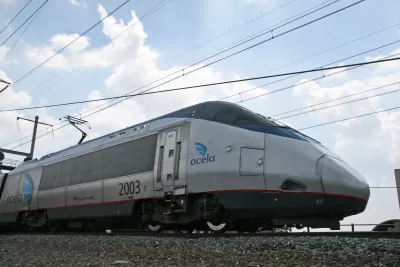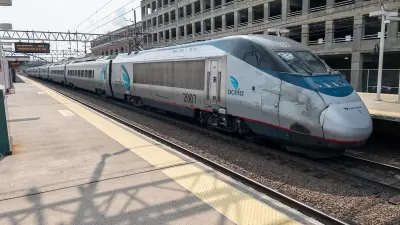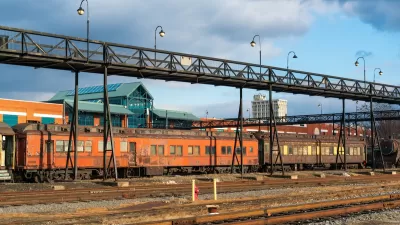Changes to boarding platforms and a switch to electric trains could improve U.S. passenger rail service without the added cost of high-speed rail.

A new report by the NYU Marron Institute’s Transit Costs Project by researcher Nolan Hicks suggests a “suite of targeted improvements” dubbed the “momentum” framework that could speed up passenger rail service in the United States by up to 30 percent — without high-speed rail.
As Benjamin Schneider explains in Bloomberg CityLab, “Hicks’ Momentum approach achieves its time savings not so much from increasing top speeds, but from reducing the “dead time” trains spend idling at stops and getting back up to speed again.” According to Hicks, U.S. trains spend a lot of time at stops due to low boarding platforms that extend boarding time for passengers and diesel locomotives that take longer to start up and get up to speed.
“The first intervention Hicks recommends is high-level boarding platforms. This ADA-accessible design allows passengers to walk or roll aboard without alighting any stairs. It also enables a train car design with wider doors, so more people can get on and off more quickly.” More importantly, electrified trains would accelerate at twice the rate of diesel locomotives, letting trains travel at maximum speed for more of the trip.
“In effect, Hicks is calling for a national rail network built up to the standards of the Northeast Corridor — not a world-class high-speed rail line, but a popular, profitable route that dominates the travel market in its region.” These upgrades could be more attainable for U.S. rail markets, but obstacles such as shared tracks with freight lines and NIMBY resistance to electrical wires and infrastructure remain.
FULL STORY: The Secret Formula for Faster Trains

Trump Administration Could Effectively End Housing Voucher Program
Federal officials are eyeing major cuts to the Section 8 program that helps millions of low-income households pay rent.

Planetizen Federal Action Tracker
A weekly monitor of how Trump’s orders and actions are impacting planners and planning in America.

Canada vs. Kamala: Whose Liberal Housing Platform Comes Out on Top?
As Canada votes for a new Prime Minister, what can America learn from the leading liberal candidate of its neighbor to the north?

Washington State’s Parking Reform Law Could Unlock ‘Countless’ Acres for New Housing
A law that limits how much parking cities can require for residential amd commercial developments could lead to a construction boom.

Wildlife Rebounds After the Eaton Fire
Following the devastation of the Eaton Fire, the return of wildlife and the regrowth of native plants are offering powerful signs of resilience and renewal.

LA to Replace Inglewood Light Rail Project With Bus Shuttles
LA Metro says the change is in response to community engagement and that the new design will be ready before the 2028 Olympic Games.
Urban Design for Planners 1: Software Tools
This six-course series explores essential urban design concepts using open source software and equips planners with the tools they need to participate fully in the urban design process.
Planning for Universal Design
Learn the tools for implementing Universal Design in planning regulations.
Central Transportation Planning Staff/Boston Region MPO
Heyer Gruel & Associates PA
Institute for Housing and Urban Development Studies (IHS)
City of Grandview
Harvard GSD Executive Education
Regional Transportation Commission of Southern Nevada
Toledo-Lucas County Plan Commissions





























